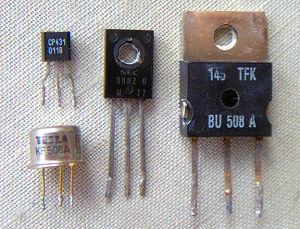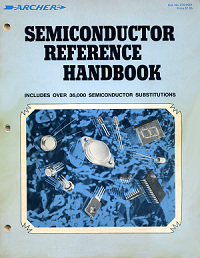Transistors & Hobby ElectronicsHobby electronics got a huge boost from germanium transistor circuits. The first hobby germanium transistors came out in the early 1950s. One of the most famous germanium devices was the Raytheon CK722. In 1953, Raytheon began selling this part to eager amateurs, experimenters and science fair builders. The “hobby grade” devices gave manufacturers a way to sell parts that met their specs, but weren't quite up to “industrial grade.” Meanwhile, hand-selected versions of the same part went into the first solid-state hearing aids. |

|
|
|
|
Parts Grades
Bargains vs. Uniformity. “Bargain bag” and “no-name” devices are a step below “hobby grade.” A bargain bag device might not resemble anything else in the bag. Unless you're lucky, matches are very difficult. If you get one “bargain bag” project working, duplicating your success is a trial-and-error situation. “Hobby grade” includes parts that might not match industrial specs, but might work fine in a hobby project. Motorola's now-obsolete “HEP” line included such parts at retail prices. Today, the hobby-grade category encompasses those eBay deals that usually arrive from foreign countries. The price points can be below wholesale. But specs rarely match the brand-name industrial devices that they supposedly emulate. I've received “2N2222A” transistors with betas of 350 to 400. The equivalent U.S. part would have a beta of 200 these days. (Although old 2N2222A parts only had a beta of 50.) In another eBay buy, I received 2N5457 JFETs with a transconductance that measured unusually low. Oh well, win some, and lose some! (Either way, the parts all worked, and the price was right.)
Tape-and-Reel Parts. When solid-state manufacturing ramped up, “tape and reel parts” became available. These parts are gems. Tape and reel parts sometimes include brand-name parts, but at a discount. Other tape and reel parts only include “house” numbers that nobody can match. But usually these mysterious parts work just fine as substitutes for name-brand parts in the experimenter magazine schematics. And, like brand-name products, tape and reel parts have uniform performance. For more about parts grades, see... Schematics.
| Transistor Parts Grades | ||||||
| ◀ Economy Reliability ▶ | ||||||
| Grade 1 | Grade 2 | Grade 3 | Grade 4 | Grade 5 | Grade 6 | Grade 7 |
|
Bargain Bag & No-Name |
Hobby Grade |
Tape & Reel, House Numbers |
Tape & Reel, Brand Name |
Replacement-Line Parts | OEM Parts, Retail | OEM Parts, Wholesale |

|
Replacement Lines. Several manufacturers released hobby transistor lines. Other manufacturers made “replacement transistors” available to amateurs. Among these were Sylvania's ECG line, RCA's SK line and Radio Shack's Archer or 276 line. You can still buy Radio Shack parts, but every year, the line grows shorter. Long ago, Radio Shack published a transistor replacement book. During the best times, Radio Shack parts could replace over 120,000 semiconductors. Actually that trick was easy, because a 2N2222A (276-2009) would replace most NPN, small-signal devices! Here's the datasheet for this wonderful device... 276-2009 datasheet Today, Radio Shack's transistor sub book is out of print. Now the store only stocks a few transistors. Fortunately, one of these is still the famous 276-2009. This is actually a Motorola MPS2222A. As Shakespeare would have called it, “a rose by any other name...”
|
Replacement vs. OEM parts. In the good old days, one of the hobby lines was the Motorola's dearly departed HEP line. If your schematic specifies HEP parts, you need to find a replacement. Today, some jobbers carry the NTE line of popular replacement transistors. The NTE cross-reference is very helpful. You'll find this reference online. On the other hand, experimenters with a current part number can easily order OEM parts. There are several good vendors that allow online ordering. OEM parts are an exact match for the needed part. When you buy from an online wholesaler, the OEM part is usually cheaper than the replacement line part. Also, there is no equivalency problem. While the replacement part might work in some or most circuits, the OEM part works in all circuits. And buying wholesale can save the experimenter 90 percent off retail.
Go to Page: 1 2 3 4 5 6 7 Next
- Conversion Introduction
- Conversion Problems
- Conversion Process
- Conversion Examples
- Necessary Circuit Changes
- Advantages or Problems?
- Transistors & Hobby Electronics
- Parts Grades
- Project Vendor Links
- Convert Your Amplifier from Germanium to Silicon
- Replacement Transistors, Capacitors & Diodes